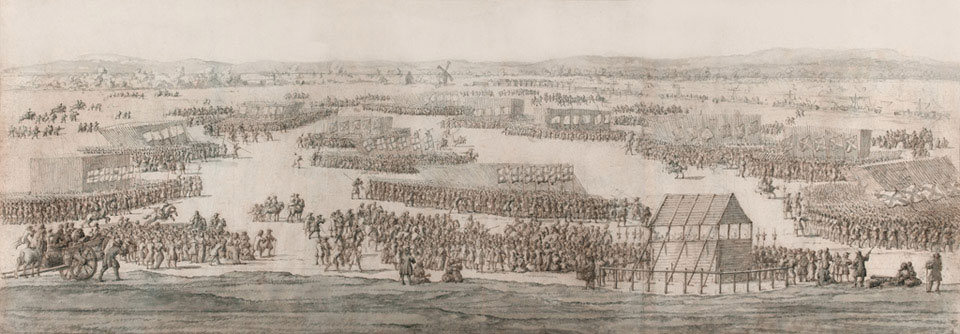
Online Collection
« Prev - 1 of 1 results - Next »
A Grand Review on Hounslow Heath, 1687
Sepia pen and ink with grey blue wash by Willem van de Velde the Elder (1611 (c)-1693), 1687 or 1689.
Hounslow Heath was an area of open land west of London. King James II (1685-1688) increased the size of the regular Army and held annual military reviews there. Holding a military muster so close to the seat of government at Westminster was deliberate - the King was using the Army to threaten Parliament.
The King thought that with the Army under his control he would be able to introduce unpopular reforms and move towards a more 'absolutist' style of government, ruling with less need to consult Parliament.
James' attempts to secure religious toleration for Roman Catholics, and the dismissal of Protestant officers from his Army, led a small group of Protestant statesmen to invite his son-in-law, William of Orange, to England. James fled and, in the 'Glorious Revolution' of 1688, a Protestant monarchy was reinstated under King William III and Queen Mary II.
Parliament never forgot the threat posed by Royal control of the Army. In 1689 it introduced the Bill of Rights, which withdrew the monarch's right to suspend or implement laws without Parliamentary consent. That same year it also passed the Mutiny Act. This required Parliament to give annual consent to the continuation of a standing army. No longer would British monarchs be able to govern without Parliament for extended periods of time, or keep up an army without Parliamentary approval.
NAM Accession Number
NAM. 2002-11-682-1
Acknowledgement
Purchased with the assistance of the Art Fund (formerly the National Art Collections Fund or NACF) and supported by the Heritage Lottery Fund


Copyright/Ownership
National Army Museum, Out of Copyright
Location
National Army Museum, Formation gallery
Object URL
https://collection.nam.ac.uk/detail.php?acc=2002-11-682-1

